Did you know that Argentina spans the same length from north to south as the distance from Portugal to Russia? It’s no wonder you’re feeling overwhelmed planning a trip to such a huge country.
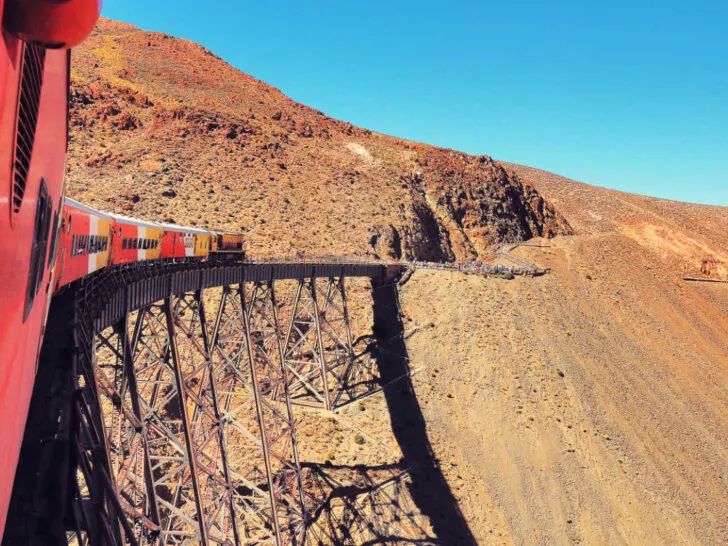
I’ve spent the past 14 years traveling Argentina from north to south, falling in love with countless sunsets, mountaintops, and deserts.
A trip to Argentina is one of a lifetime, whether you’re here for a week or a month. Here are my suggestions for how to travel around the country.
How to navigate Argentina
There are a couple of key websites and apps that will help you get around in Argentina.
- Google Maps can be helpful whether you’re walking, taking a taxi, or using public transport. Just be aware that announced business hours work on Argentine time (this means that Google may not be updated for holidays when they’re closed or at siesta time, 1:30-3pm).
- Buenos Aires, like any big city, has some areas to avoid for safety. You can check out this map showing neighborhoods and streets to avoid (especially after dark).
Planning Your Trip to South America?
Save time, stress & money with a customized travel itinerary planned for you by a South America expert
- Use travel app Waze to get updates on traffic, protests, and police radar. It’s similar to Google Maps, so you can plug in your destination and it’ll provide you the best route to drive. Waze is especially helpful if you need to chart an alternate route during high-season traffic. It also saved me from getting speeding tickets in Cordoba (SEE below on the infamous Cordoba cops).
- AllTrails is one I discovered in Patagonia, when I couldn’t find the trailhead to a waterfall and asked a friendly hiker for tips. Pay for the annual subscription and you get offline navigation and printable maps.
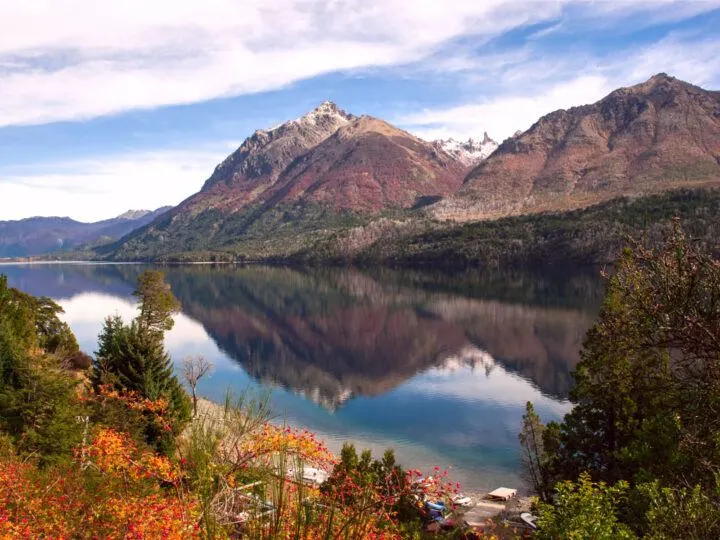
- Maps.me has downloadable maps (just make sure to download them before arriving at your location without cell service). You are limited to 10 free map downloads without signing up for a yearly subscription. If you already use Maps.me in other countries, it’s worth a try but I hear new updates have made it slow and buggy.
- iOverlander is a useful resource for off-road camping and van travelers.
Purchasing an Argentine SIM card
Argentina is a country with large amounts of unpopulated territory and remote tourist destinations. Sometimes, an eSIM won’t always provide the best coverage, so it’s advisable to purchase a local SIM card if you plan on traveling to the North or Patagonia.
I recommend Claro for its broad coverage. You can purchase a SIM card at the Ezeiza airport kiosk, or any city kiosk, asking for “chip Claro”. If you have an unlocked phone, bring your passport and debit card to one of the official Claro locations (try Alto Palermo Mall) and request a “chip Claro turista”. You can also get an eSIM at Claro stores. Claro offers the lowest prices on data top-ups (go to a kiosk and say “quiero cargar datos con Claro”; only cash is accepted).
However, depending on your travel itinerary, other companies might work better. For example, Movistar is superior if you’re going to Salta.
Keep in mind that your Argentine SIM will only work for you inside the country, and not if you visit neighboring countries. If you want a SIM that covers other countries beyond Argentina, look into an eSIM like Airalo global.
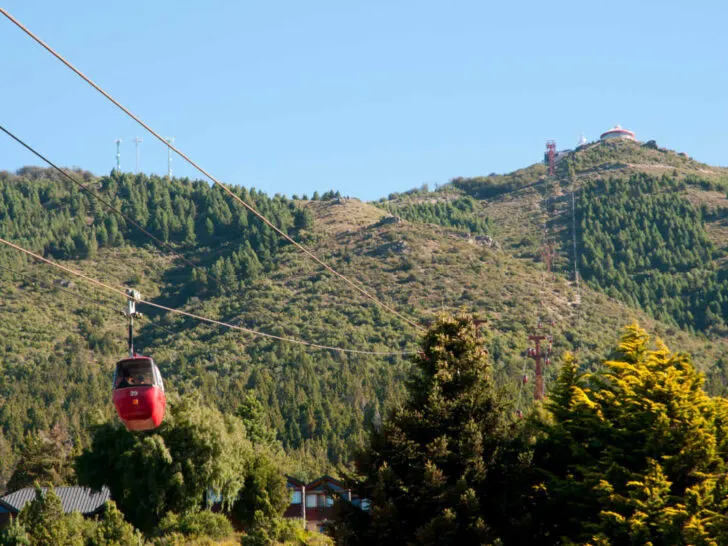
It doesn’t need WiFi to work, uses local networks, and works in some Central and South American countries — although it’s hit or miss depending on your phone. Inside the city of Buenos Aires, it has been reported that Airalo service is a little sketchy.
If you need to check text messages to your home country’s phone number, you’ll need to toggle back and forth in your cellular settings. If your phone network in the US is T Mobile, you can still receive text messages and access your internet allowance free of charge, although coverage is spotty in Buenos Aires.
Flying in Argentina: key facts
- The most important thing to remember about flying in Argentina is to have patience. For a country whose length stretches over 2,200 miles, airplane travel is an underdeveloped industry. Plagued by years of government appropriation and socialist union strikes, the game changes every few years.
- Most cities in Argentina have an airport and are well-connected to Buenos Aires.
- Direct flights between regional cities are limited. As a result, when traveling between different parts of the country, you’ll typically need to connect through Buenos Aires, even if you’re flying between two destinations in the south, such as Bariloche and Ushuaia.
- There are no direct flights between El Calafate and Ushuaia, and El Calafate and Bariloche. Airlines will route you through Buenos Aires, where you’ll spend 7-10 hours on a layover. These flights run ~$300-$900 USD so I recommend planning your Patagonian travel itinerary carefully.
- For domestic flights, you need to be at the airport at least 1.5 hours in advance of your flight. Traffic can be terrible in Buenos Aires, so give yourself plenty of time to reach the airport.
- It’s impossible to fly to destinations in Chile from any Argentine airport except those in Buenos Aires – and there are only flights to Santiago from there. It’s therefore easier to cross the border into Chile by bus.
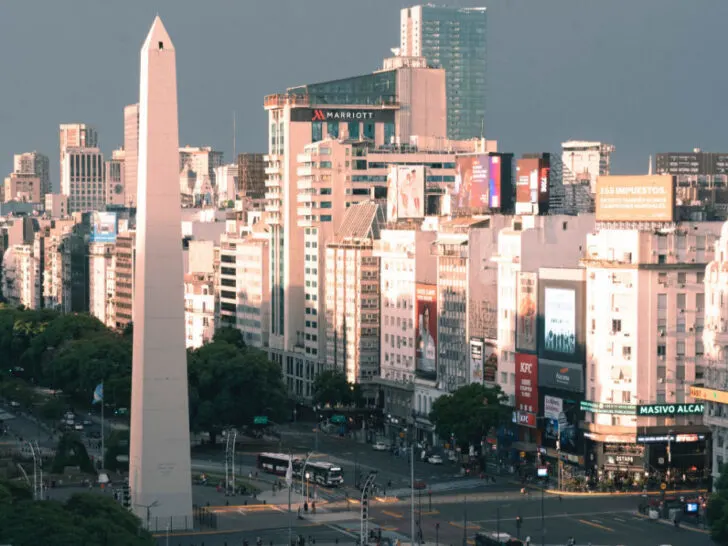
- You can skip Buenos Aires and fly directly to wine country in Mendoza. Starting October, 2024, there will be American Airlines flights available that stopover in Santiago de Chile before landing in Mendoza.
- Because Argentina has strong workers unions, any time there’s a national strike this will affect airlines as well. All airlines must obey the strike, however, during a recent strike Aerolineas rescheduled about 75% of domestic flights relatively quickly, and FlyBondi ended up canceling ~10% of their flights.
Airports
Aeropuerto Internacional Ezeiza
The main international airport is called Aeropuerto Internacional Ezeiza (EZE) and is located about an hour outside Buenos Aires.
- There is free airport WiFi to call a car service but you will need to drag your bags to the approved area.
- Uber, Cabify, and Didi all work well. The trip should cost ~$15 USD, depending on your hotel location in Buenos Aires.
- You can also take a Tienda Leon car service (expensive but secure).
- Taxi drivers will unabashedly try to overcharge the trip (and even threaten to steal your luggage if you don’t pay).
Aeroparque Jorge Newbery
Buenos Aires’ smaller airport is called Aeroparque Jorge Newbery (AEP) and is located in the neighborhood of Palermo.
- Usually, travelers will take domestic flights out of this airport, so there are long lines during every holiday weekend and summer season.
- If you fly into Aeroparque and call an Uber, you have to walk a distance to the pick-up area with your bags.
- As of October 27th this year, it will begin offering international flights to other Latin American countries (Brazil, Chile, Perú, Ecuador, Uruguay, Panama, Paraguay).
Airlines
- Aerolineas Argentinas is the national airline, and one of your best options, depending on how many bags you’re traveling with, and your final destination. The website can be translated into English, which makes it easier to navigate. Often, their prices are cheaper than the supposed “low-cost” options below.
- JetSmart is a reliable low-cost airline. Like all low-cost options, checked bags are charged separately. The website is available in English as well.
- FlyBondi was the first low-cost airline in Argentina. However, it’s been plagued by delays, cancellations, and even major accidents. It’s currently ranked “most dangerous low-cost airline” in the world, with the highest amount of flight cancellations (30%). The website is in Spanish and prices are in pesos.
Expert tip: if you only plan on visiting Argentina for a few days, don’t save money by flying the budget airline FlyBondi. On two out of three of my flights with them, I’ve experienced five- to eight-hour delays where I couldn’t leave the gate at the airport. Not only will you die of boredom and vending machine food, but you’re also likely to miss half of the weekend trip you planned. This is caused by a very small fleet of planes that need constant maintenance. You’ll hear about other travelers who don’t have any problems, but it can be seasonal/depending on your destination.
Which destinations should you fly between in Argentina and which are better by bus?
Are you traveling on a budget? Do you have a shortlist of top sights to see and plenty of time to spend in Argentina? Traveling by bus might be the thing for you. Long-distance buses can take you from Buenos Aires to wine country in Mendoza, or whale watching in Puerto Madryn, all for the cheap price of under $100.
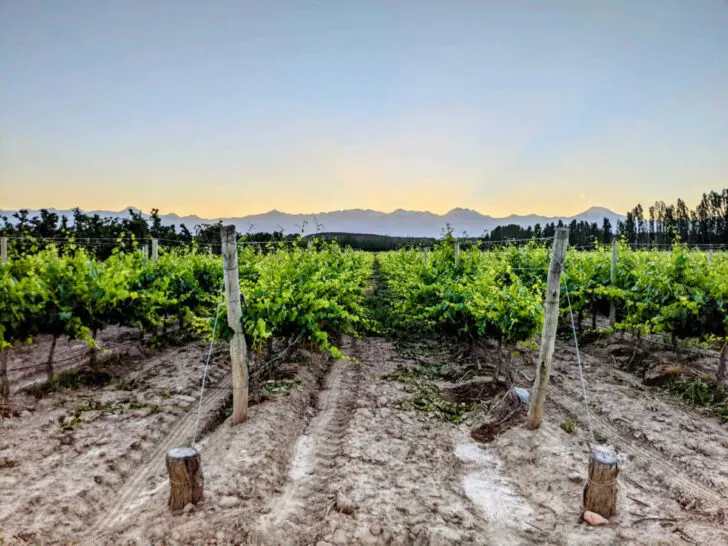
However, be prepared to spend a whole day on the bus.
When I was 19 I studied abroad in Argentina and, as a poor college student, was determined to travel on a budget. Back then, airlines charged foreign tourists a premium so I was stuck with 24-hour buses to visit my top destinations: Iguaza and El Calafate.
It actually turned out to be MULTIPLE 24-hour buses to get there. I will never forget the dubbed Spanish version of High School Musical played on repeat on the bus. However, I was pleasantly surprised by the quality of the reclining seats and free wine and whisky.
Ten years later, my parents visited and I took them to Mendoza on an overnight bus (one because my dad has a fear of flying and two to save money). The whole experience was pretty great; we left from Buenos Aires and arrived in Mendoza city in the morning.
These days, if you purchase your ticket months in advance with a low-cost airline, it’s up to two times the cost of travel by bus. And you arrive in two to three hours vs 20 hours.
However, for cities that are only a few hours apart, it makes more sense to travel by bus or rent a car.
- Jujuy to Salta (2.5 hrs by bus, tickets are only 2.5% the cost of a flight)
- Bariloche to El Bolson (2.5 hrs by bus, tickets are $10)
- El Chalten to El Calafate (3 hrs by bus, tickets are $22)
In Buenos Aires, the main bus terminal is called Retiro Station (BUE). You can purchase long-distance bus tickets in person at the station (cash, cards) or online (credit/debit cards).
Keep in mind that you might not find advance bus tickets available online (some companies don’t release them more than 30 days in advance).
Make sure to stay aware of your belongings in Retiro, as it’s one of the most dangerous spots for pickpocketing. That’s because it’s next to a slum called Barrio 31. There have even been cases where the bus in motion was robbed by gangs to steal luggage.
Flights
Argentina’s transport system (both flights and ground transport) is centered around Buenos Aires as a main hub. It’s historically how the country was built and just the reality that travelers have to adjust to when visiting Argentina.
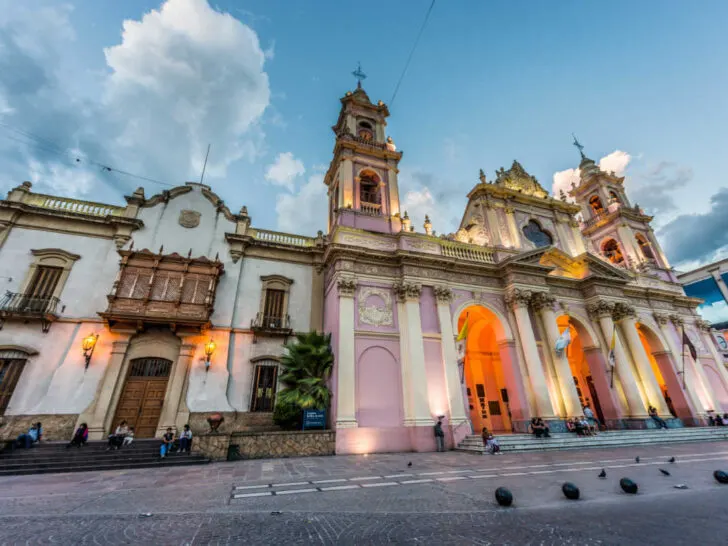
That means that what might seem like common logic to fly in between tourist destination cities or take buses to save money doesn’t always make sense in Argentina, especially because of the long distances between destinations – some require several 24-hour buses to arrive.
I’ve outlined key destinations you might choose to travel between, including the cost of the flight and bus (where there is one).
| From | To | Flight duration | Flight average cost inc. one checked bag | Bus duration | Bus cost (180° reclining seat) |
| Buenos Aires (AEP) | Puerto Iguazu (IGR) | 1hr 50 mins | $120-$230 USD pp | ||
| Buenos Aires (AEP) | San Salvador de Jujuy (JUJ) | 2hrs 10 mins | $145-$185 USD pp (Nov-Feb); $323 USD pp (July-Sept) | ||
| Buenos Aires (AEP) | Salta Capital(SLA) | 2hrs 15 mins | $210-$225 USD pp (Nov-Feb); $234-$306 USD pp (July-Sept.) | ||
| Buenos Aires (AEP) | Mendoza Capital (MDZ) | 1hr 40 mins- 2hrs | $111-$225 USD pp (Nov-Feb); $177-$366 USD pp (Jan-Mar) | 17 hours | $50 USD pp |
| Buenos Aires (AEP) | Bariloche(BRC) | 2hrs 5 mins-2 hrs 25 mins | $135-$225 USD pp | ||
| Buenos Aires (AEP) | Puerto Madryn (PMY) | 1hr 50 mins | $120-$220 USD pp | 19 hrs 35 mins | $80 USD pp |
| Buenos Aires (AEP) | El Calafate(FTE) | 3hrs-3hrs 20 mins | $195-$340 USD pp | ||
| Buenos Aires (AEP) | Ushuaia(USH) | 3hrs 40 mins | $295-$425 USD pp | ||
| San Salvador de Jujuy (SSJ) | Salta Capital (SLT) | 2 hrs 25 mins | $10 USD pp | ||
| El Chalten (ECHA) | El Calafate (CLFT) | 3 hours | $22 USD pp | ||
| Bariloche (BAR) | El Chalten (ECHA) | 27 hours | $105 USD pp |
Driving in Argentina
Argentina has some of the longest continuous roads in Latin America, traversing dramatic landscapes that run from north to south, so it should come as no surprise that it’s the perfect place for a road trip.
Ruta 40 is the most famous, with over 5,220 kilometers (3,000 miles) of road crossing through 11 provinces and 21 national parks. It’s also the route with the highest altitude outside the Himalayas (5,000 meters/16,404 feet at its highest point).
It’s no surprise, therefore, that the main road trip sections lie along the Ruta 40. To drive the entire road, end to end, would take over a month.
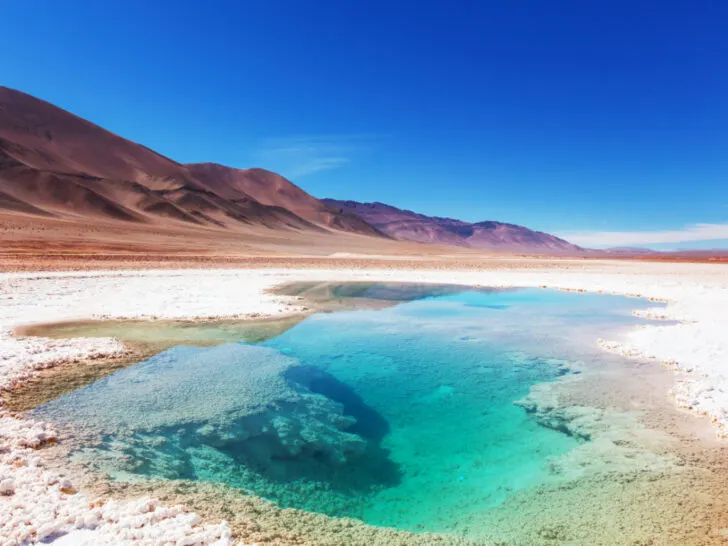
The best scenery can be found on the North stretch (that goes through Salta, Jujuy, Tucuman, and Catamarca provinces) and the Patagonia stretch (Neuquen, Rio Negro, Chubut, and Santa Cruz provinces).
Driving long distances on rural routes cross-country is often pretty enjoyable. Unlike city driving there’s no road rage, playing chicken at intersections, and drunk drivers heading home from the club.
However, there are some key things to consider:
- Fuel is expensive in Argentina. For an oil-drilling country, gasoline has always been expensive in Argentina compared to other Latin American countries. Under the new administration, prices have risen to make Argentina #1 on that list. A liter runs ~U$1 (or ~U$4 per gallon).
- Ruta 40 is pretty isolated from gas stations and nearby towns. Bring sufficient gasoline, water, a hat and sunblock.
- Some gas stations only sell diesel. You can ask car hire companies for an extra gas can to avoid running out, but always fill up when you seen a gas station.
- Avoid driving on the Northern Ruta 40 during the summer or winter (rainy seasons), as flash floods wash out the road every year.
- For the southern portion, the best time is in the summer (November-March).
- Road conditions can be poor. Watch out for potholes, falling rocks, roads completely washed out, roads that lead to nowhere (abrupt ending) and detours without warning, lack of gas stations (some are only for diesel).
- Getting bored is a serious issue for drivers here. Believe it or not, there are signs telling you to stay awake.
- Keep an extra gallon of water in the car in case the radiator overheats. Argentina’s broad range of climates – from desert to glaciers – and seasonal weather patterns can affect your road trip experience. If you plan on driving across the northern provinces, especially Salta and Jujuy, in the summer months (November-February) beware that it’s the rainy season and temperatures can reach up to 110ํ℉ (40℃+).
Northern Ruta 40
Much like the arid American Southwest climate, this part of Route 40 boasts giant cacti, Martian-looking landscapes, rugged mountain ranges, and herds of llamas. You’ll feel all the adventure of the colonial settlers in Argentina when they first explored this region. The food is slightly spicy and the people are inviting.
Highlights
- Salinas Grandes, picturesque high altitude salt flats that are still used for salt mining
- Parque Nacional Los Cardones, with its cactus forests
- Bodega Colomé, known for its brilliant wine and the Museo James Turrell, a museum of an international artist that works with light
- Quebrada de las Flechas, which is a canyon lined with pointed rocks that look like a glacier turned to stone
Car and van rentals
- I’ve driven around Salta before and rented a car from Wave Rent A Car in Salta. I recommend an SUV to handle rocky areas of the road.
- Camper vans can be rented somewhat economically from Argen Camper.
Southern Ruta 40
Argentines often boast that this part of the country is a dead ringer for the mountains and lakes of Switzerland. Views of glacier-fed lakes and lush forests can be enjoyed from the southern stretch of Ruta 40.
Roads are well-maintained and driving is relatively easy before you get further south.
Highlights
- Termas de Caviahue, a natural spa and hot springs at the foot of Volcán Cophahue
- The Route of the Seven Lakes, a beautiful drive through lakes between San Martín de los Andes, Villa La Angostura, and Bariloche),
- El Bolson, a hippie commune with artisan markets and hiking trails
- The Cueva de las Manos, cave paintings believed to date between 9,000 and 13,500 years ago
- Lago Buenos Aires, the second-largest lake in Latin America and one of the region’s most picturesque (also known as Lago General Carrera on the Chilean side)
- Glacier Perito Moreno, one of Patagonia’s most accessible glaciers
Car and van rentals
It’s easiest to rent a car in Bariloche, although you’ll need to book weeks in advance during the tourist season of November-February.
- I recommend Hertz rentals. If you only drive automatic, prices are significantly higher and fewer cars are available.
- Search Motorhome Republic for van rentals.
- High-end campervans and motorhomes can be rented in Bariloche from Bariloche Motor Home.
El Calafate to Ushuaia
An exciting final route that leads to the end of the world in the southernmost city on Earth. Some stretches can get iced over, even during summer months.
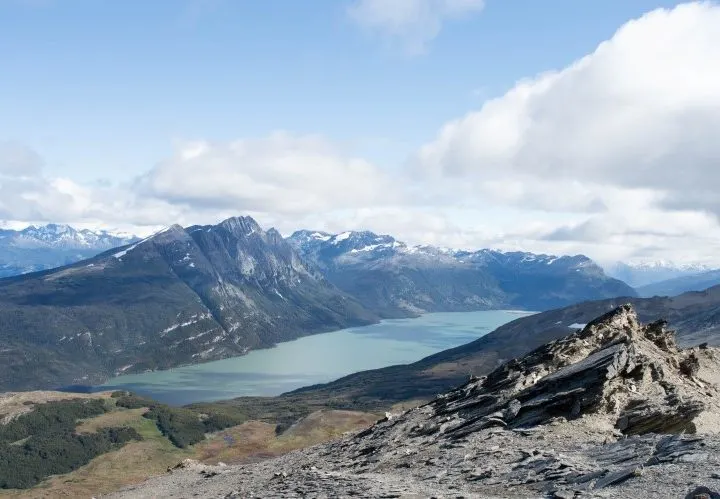
Route 40 ends eventually at the island of Tierra del Fuego, where you’ll need to take your car on a ferry and traverse the Chilean part of the island before crossing back over the Argentine border to end in Ushuaia.
It’s important to note that it is a legal requirement to have snow tires if driving in Ushuaia, which has an additional cost – although how often this is enforced I don’t know.
Highlights
- Wildlife sightings, including guanaco, wild hare, king penguins, and sea lions
- A ferry ride across the Strait of Magellan, where toninas (Chilean dolphins) can be spotted
- In Ushuaia, you can take a speedboat along the Beagle Channel to visit the iconic Les Eclaireurs Lighthouse and gorge yourself on king crab and Chilean seabass
Car and van rentals
- Not many rental agencies will approve a one-way drop-off on this route since it crosses over into Chile and back, but you can find a few (manual-only) cars on Rental Cars.
- I recommend you find a way to spend an extra day of non-stop driving (11 hours) to loop back and leave the car at the original rental agency.
Campers (vans and pickup trucks) can be rented in El Calafate from Full Campers.
How to continue your trip into Chile
If you start your Ruta 40 road trip in the North you can cross over to Chile at various points. You must request and pay for the additional insurance required to drive in Chile (request this at least two weeks in advance of your rental period starting).
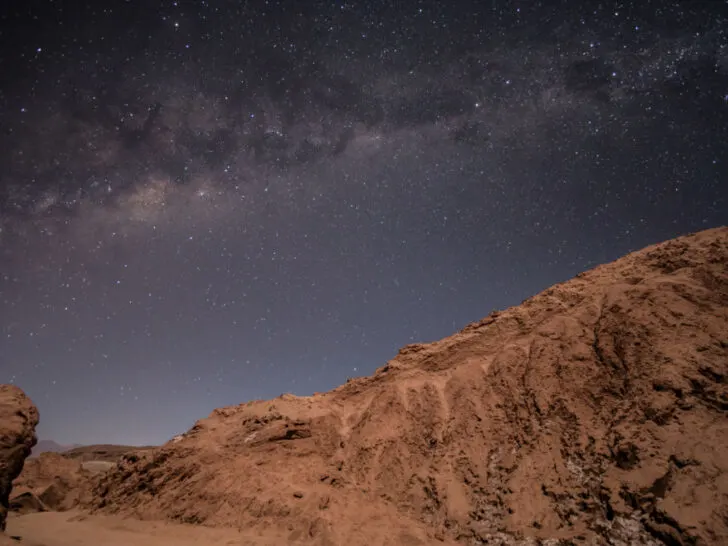
You are not allowed to take vegetable or animal products into Chile from Argentina; border guards are meticulous and will scan your belongings and also look through your vehicle.
Always declare anything – particularly things you’re unsure as to whether they’re permitted – as you can receive a hefty fine if you don’t and you’re discovered to have these items with you.
In the Atacama Desert:
- Salta: Paso de Jama
- Salta: Paso de Sico
- Between Salta and Mendoza: Paso de San Francisco
Middle of the country:
- Mendoza: Paso Los Libertadores, the most transited route to cross over to Chile by car and where Latin American hero San Martin led his army. However, this is accessed via Route 7, so it’s a bit of a detour from the main road trip routes.
In Patagonia:
- Bariloche: Paso Cardenal Antonio Samore, the same route taken by Che Guevara
- Los Antiguos: Paso Río Jeinemeni, the shortest crossing, which takes you onto the Carretera Austral (another top road-trip destination!)
- El Calafate: Paso Don Guillermo, where the border agents are the most meticulous when it comes to enforcing the no animal or vegetable products rule.
- Ushuaia: Paso San Sebastián, depending on if you come from El Calafate or Rio Gallegos, this can require multiple crossings into Chile, plus a ferry over the Strait of Magellan
Insider tip: Before you hit the road, check to see if your home country has diplomatic relations with Chile. If not, you’ll need to request a tourist visa before entering.
Citizens of Canada, Mexico, Australia, and Albania have to pay a reciprocity tax of ~$25-$135 USD per person. If you plan on renting a car, you must inform the rental agency first so they can complete the appropriate paperwork to register your intent to cross the border to Chile at least 14 days in advance. This costs from $150 USD.
When you cross the border checkpoint, you will each receive a PDI slip, a bit of paper stamped by the border officials that is effectively your visa for the 90 days of its validity. Make sure you don’t lose it! You’ll need to hand it over once you cross back out of Chile.
Hiring a car in Argentina
Hiring a car is an easy process and something that many visitors to Argentina opt to do, both for the opportunity to explore its iconic roads and also because it can often speed up your travel time between destinations otherwise served by buses.
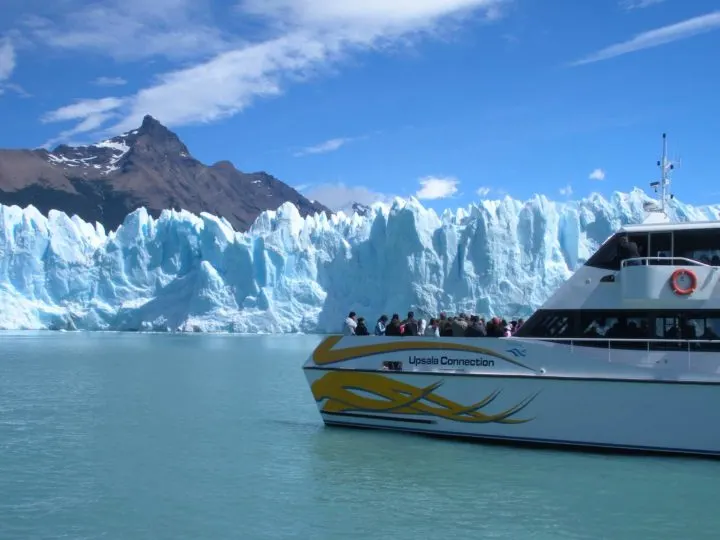
Before you hire, here are some key things to know:
- The average cost per day for a rental car is U$145 USD. This is without additional insurance or upgrades and is slightly higher than other countries in the region. If planning on traveling in Patagonia, it can make far more sense to hire in Chile, where prices start from $25,000 CLP ($30 USD), and then cross into Argentina with the vehicle.
- One-way trips with a different drop-off destination are extremely expensive. This is because of the vast distances between towns. You can expect to add an extra cost of $1,000-$2,000 USD to your reservation.
- The most reliable and trustworthy rental agencies are Hertz and Avis.
- Car models available in Argentina might not be as spacious or comfortable as you’re used to back home. Most cars are fabricated in Brazil – with cheaper parts and less strenuous safety tests.
- If you don’t know how to drive a stick, you’ll be at a disadvantage when it comes to renting a vehicle. Few automatic cars are available at rental agencies, and if you travel during the high season (late December to February, or March to May in Salta & Jujuy) you may be left without many options or pay extremely high rental fees (almost the same as a flight costs).
- It’s recommended that travelers have experience with van mechanics or repairing tires since it’s common to have a tire blow out on uneven roads. Nearby mechanics (mecánico automotriz/RV) may not have the parts required to make the fix and you can be stuck waiting in their town for weeks or longer.
Payment and driving licenses
- A credit card (not debit card!) and your passport are required to rent a car. You must hand them a physical card in your name. The card will be put on file, with a charge to hold the reservation and your account must have a balance to cover that charge.
- Your driver’s license and passport must be issued by the same country to be valid.
- To rent a car, you must be aged 18+ and drivers who are 18 to 21 pay an additional fee as novice drivers. In Argentina, you don’t get your license until 17.
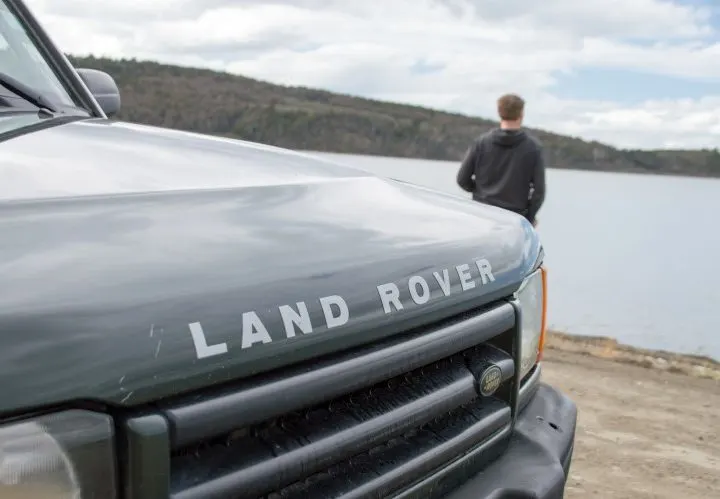
- An international driver’s license is not required. However, you must hold a valid license issued by one of the following countries (the United States, the UK, Australia, South Africa, Switzerland, any country within the European Union or European Economic Area, or a country under the Vienna Convention on Road Traffic). The license must be printed in English using the Latin alphabet.
Insurance
- Before driving your rental car, take an exhaustive number of photos as evidence against false claims by the rental agency. I recommend taking those of the car’s windshield, tires, bumpers, and other details
- Read the terms and conditions of the hire carefully. Some don’t permit you drive on “grava” or “ripio” (unpaved roads, of which there are many in rural Argentina!) with their most basic insurance policy.
- Many companies, including Hertz and Avis, offer a zero-excess insurance policy at an additional cost. This means you won’t be required to pay the excess – which can cost upwards of $500 USD – if you have an accident or issue with the car – something not unlikely due to the poor road conditions. However, it can be significantly more expensive than buying an LDW policy (see below).
- A Loss Damage Waiver (LDW), which includes a Collision Damage Waiver (CDW) and Theft Protection (TP) can be significantly cheaper than a zero-excess insurance policy. This additional insurance coverage means the insurance company will pay the excess if you have an accident or issue with the car. Purchasing an LDW policy from an insurance broker based in your home country rather than a zero-excess policy from the rental agency will be far cheaper. I’ve heard Rental Cover recommended (they provide coverage for people all around the world and you can read how it works here).
- It’s highly recommended to pay more for insurance policies that cover windshield damage. This is a frequent issue for travelers exploring unpaved roads – of which there are many – in Argentina and can be very costly to fix without this level of insurance.
- It’s best to not rely on the credit card company if you get in an accident. While some credit cards offer car insurance coverage, paperwork can actually end up delaying your travel itinerary.
- DO NOT sign up for insurance beyond the basic level automatically included in the package if you have an LDW insurance policy from your home country. Your coverage will be annulled if you do.
- Many hire companies don’t offer roadside assistance. Check the terms and conditions of your policy carefully, as many (such as Avis and Hertz) don’t cover the cost of towing fees.
- If you break down across the border in Chile, repair work and towing will typically be at your own expense.
Campervan rental
Campervans, which are referred to as “camper”, “camperbox” or “motorhome”, are a great option for Argentina, too, giving you the freedom to park up and will in beautiful destinations around the country.
- Few rental agencies have automatic campervans to rent.
- You will find better quality, and more automatic vehicles, in Bariloche or across the border in Chile.
- High-end campervans and motorhomes can be rented in Bariloche. I suggest Bariloche Motor Home.
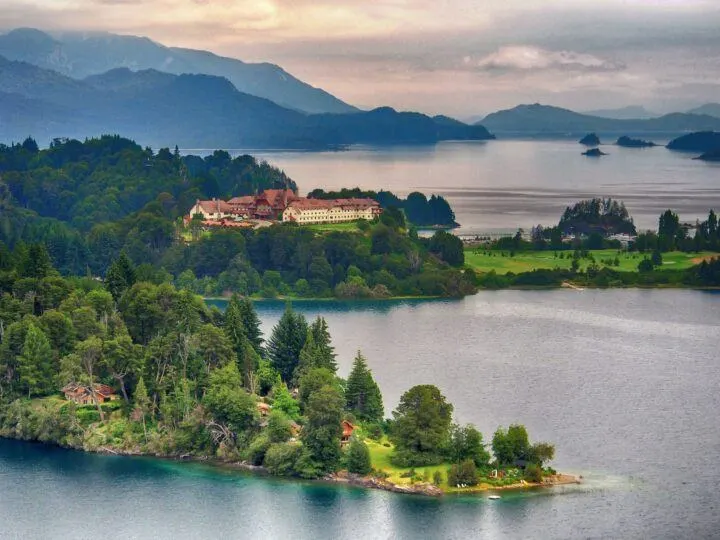
- In Chile, there are various options for campervan rental. These include Pucón-based Chile Campers, Punta Arenas-based Andes Campers, as well as Condor Campers and Soul Vans, who cover multiple destinations. For RVs, look up Holiday Rent, who can similarly arrange pick ups across the country.
Handy apps for campervan travelers are iOverlander and Park4Night. The former provides information about road conditions, while both include locations and reviews of free spots to park overnight – however, read below for further recommendations. Park4Night requires a paid subscription to access the app offline.
Parking up overnight with a campervan
If you plan on stopping overnight, it’s safest to park at motorhome-approved campsites with bathrooms and water access.
- Catamarca: there is paid parking in the town, El Rodeo.
- Salta: the best motorhome campsite is Xamena.
- Seven Lakes Region (encompassing San Martin de los Andes, Villa La Angostura, and Bariloche): it’s prohibited to park on public streets inside the town or next to lakes and rivers.
- Bariloche: the only free parking spot with a view of Lago Nahuel Wapi is in the lot on Avenida Juan Manuel de Rosas. Paid campervan parking spots include Petunia (kilómetro 13,500 de Bustillo), Los Baqueanos (along Lake Gutierrez), and Camping ATE (along Lake Mascardi).
- Ushuaia: there is free motorhome parking along the route to Parque Nacional Tierra del Fuego, across from the Centro de Residentes Chilenos de Ushuaia (here). If you’re in the wrong spot, usually police will give you a warning and ask you to move.
If you can read Spanish, there’s a Facebook group called Playones para Motorhome that is really helpful to find detailed recommendations per province and national park.
Road-tripping in your own vehicle
If you plan on entering the country driving a car or motorcycle with foreign plates, then you may encounter more scrutiny at police stops. To ensure an unproblematic reception, an avoid a fine, you’ll want to ensure your vehicle has:
- An illuminated rear license plate.
- Is equipped with a first aid kit, fire extinguisher, reflective triangles and vests (one per person), reflective tape on the bumper of large vans and RVs, and a tow rope.
- Have working front lights (low lights and high beams, either in a white or yellow color), rear brake lights (red color), and blinking hazard lights (used whenever you need to pull off to the side of the road or are waiting for someone to get in the car).
If your trip itinerary takes you through major cities, then the driving experience can be more focused on finding parking spots, avoiding getting towed, and intersection etiquette (right of way goes to the car on the right, shift down, and swerve to the side to not scrape the bottom of your car).
In Buenos Aires, certain areas of the city are off-limits to cars.
Road safety
Speed limits are designated by road type and protected areas (schools, etc.) and may vary from one province to the next. Cordoba province is notorious for strict radar controls.
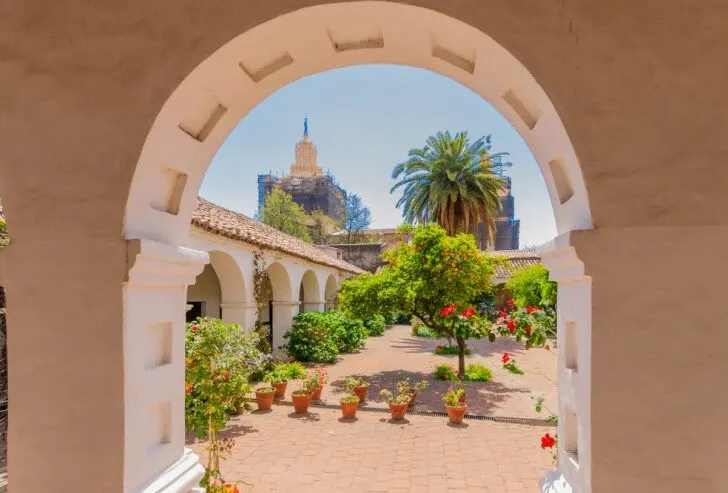
On highways, cars may drive up to 80mph (130km/h). If the road has multiple lanes (like a highway) but has intersections with other roads then the limit is under 75mph (120km/h). On a two-way road, the max speed is 68mph (110km/h) and you must keep low beams on at all times (even during the day).
If a cop stops you, they may ask for your drivers license (licencia de conducir), car registration (cedula), and insurance (comprobante de seguro). Usually, if it’s the first time you’re caught speeding you can get off with a warning by telling the officer you’re an “extranjero”. However, cops near border towns tend to be a little stricter about documentation and fines.
If you need to pull off to the side of the road, or make a stop in traffic to get in/out of the car, use your blinking hazard lights.
In the case of a crash or accident, stop driving. You should exchange your driver’s license number and insurance information with the driver of the other vehicle involved in the accident (as well as the police, if they arrive).
If the accident is on a highway, try to steer the car off to one side. Do not exit the vehicle into traffic. Should the police arrive on the scene, you may be required to sign a report.
Before planning your trip, make sure to read this post on the best time to visit Argentina according to an expert. Looking for adventure? Discover the 25 best places to visit in Argentina here, and everything you need to know about the El Perito Moreno Glacier here. Looking for a little more relaxation? Our post on the best Argentine wineries could be just what you need.
